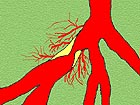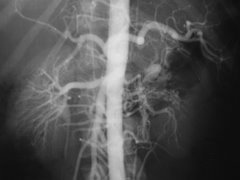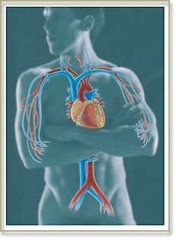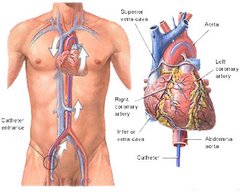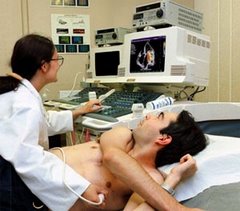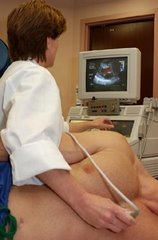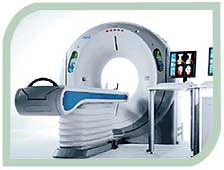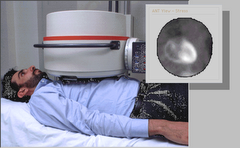Thursday, January 31, 2008
Same Song, Different Verse
So, I wasn't the least bit surprised when the cardiologist who performed my most recent cardiac catheterization concluded that the angiogram showed I needed a CABG. I would have been more shocked if he suggested the medical treatment I had been undergoing since the spring of 2004 and the Enhanced External Compression Pulsation (EECP) Therapy I took last fall had actually made the most popular cardiac surgery performed in the USA unnecessary, or at the very least, premature.
The first angiogram, performed in 2004, showed I had a 100 percent blockage in two arteries and 85 percent occlusions in three more. The cardiologist who performed that procedure four years ago, adamantly insisted a stroke or heart attack was imminent unless I had an immediate Quintuple CABG performed. He seemed personally insulted by my declaration that I was going to seek a second opinion, making the rash statement, "You are a time bomb waiting to explode." But that obvious attempt to coerce me into consenting to have my chest cracked open didn't work. I stubbornly (some would say stupidly) obtained a second opinion and even had the gall to take the medical advice of the cardiologist who provided that second opinion by choosing his more prudent medication regimen.
Today I underwent a second angiogram. I had hoped it would definitively demonstrate that my decision to opt for a nonsurgical alternative to a CABG was the correct one. It did not. However, the cardiologist at the Indiana Heart Hospital who performed the cardiac catheterization today did say some thing very similar to the doctor who performed the one four years ago. He said, "Your pump is in great shape."
That declaration alone was enough to tell me I chose the proper course in 2004. The cardiologist today said something else that was very telling. He said, "There is at least a trickle of blood going through each of your arteries." Now he said this in response to my question as to why the heart in such great shape if the arteries that feed it oxygen suck. He could have said, "The collateral vessels must be supplying the heart with oxygen." He did not. He specifically attributed the pump's great shape to the small amount of blood still being pumped through my arteries.
The cardiologist today also gave me some good news. He said the angiogram showed the left ventricular artery was not comprimised. That vessel, morbidly known as the "widow-maker" is the one artery that its occlusiion would warrant an immediate CABG.
I have an appointment to see my cardiologist on Monday, next. At that time, I plan on looking at the results of both angiograms I have undergone and the echocardiogram that was performed on Monday. Unless he provides me with a very compelling reason to undergo a CABG, I will continue the treatment of my coronary artery disease as I feel Dr. Howard Wayne would have.
I will report back to the readers of this blog on Monday February 4. In the meantime, I am soliciting the opinions and advice of all who read this blog. What do you think I should do? If it was your decision to make, how would you go about making it? Please provide your comments as soon as possible. See you next week.
Tuesday, January 29, 2008
Angina Attack
By 10 PM, I began experiencing tremors far more severe than any my Parkinson's disease ever caused. I also developed a fairly significant chest pain that lasted a couple of hours and was accompanied by sweating, nausea and vomiting -- classic signs of a myocardial infarction. I stubbornly refused to go to the emergency room and by 2 AM, the symptoms had all subsided and I felt well enough to perform the activity the pills were designed to facilitate. The chest pain returned during this time.
I decided to go to the emergency room and I drove myself to the Indiana Heart Hospital. The emergency room staff swung into action the minute I arrived and emergency treatment was quickly initiated. The monitor was hooked up, an IV established, lab work drawn, oxygen provided by nasal cannula. The on call cardiologist arrived soon after this was done and he intervieiwed and examined me. It wasn't very much longer that a doctor from my own cardiologist's group arrived and I was admitted to an observation unit.
This was the first instance of angina that I experienced since completing EECP last fall. In fact, I had not used nitroglycerin and weaned myself off of Imdur specifically so I would be able to use medications like Viagra, Cialis and Levetra. I had Levetra with me, but foolishly used the natural supplement because it had giveen such excellent results a fortnight before.
Well the good news was, I had not had a heart attack. The markers were all negative and an echocardiogram apparently turned out normal. At least I was allowed to leave the hospital a little more than 12 hours after arriving. But I left with the promise to return Thursday for an angiogram. Now, readers of this blog know I am generally opposed to this invasive test and my favorite noninvasive cardiologist is no doubt spinning in his grave because I signed a consent to undergo this cardiac catheterization. But I was faced with three choices.
One, I could continue taking the prescribed medication that has served to keep me from the cardio-thoracic surgeon's blade for nearly four years and not have the angiogram. This choice is the one I wanted to take at first because Dr. Howard Wayne had little faith in this procedure.
Two, I could have the angiogram with the plan of having stents placed or angioplasty performed. Since I am adamantly opposed to stents, this choice was eliminated as the doctor presented it to me.
Three, I could have the angiogram with the plan to have a CABG done after the procedure is completed. I again said this wasn't a choice, with the caveat that if there was evidence thaat the left ventricular artery was partially occluded, I would consent to the surgery. The "Widow Maker" is a vessel not to be played with.
I did agree to undergoing cardiac catheterization day after tomorrow for one reason. I want to compare the angiogram that was performed in 2004 with this new one. It should tell me if Dr. Wayne's medical regimen and the EECP successfully allowed my body's collateral vessel system to develop around the blocked arteries. So in actuality, I am allowing this invasive procedure to be performed so the efficacy of my treatment thus far can be evaluated.
If my body did create a viable collateral vessel system that effectively supplies my heart with oxygen, I feel that will lend credence to my decision to refuse to have a quintuple bypass four years ago. I am scheduled for the cardiac catheterization on Thursday morning. As soon as I come home from it, I will report the findings on thsi blog.
Sunday, January 27, 2008
Cholesterol Scare
There are many sites on the Internet that say the same thing. There are links to some of these sites right on the webpage you are currently reading. Finally, some mainstream cardiologists agree with the necessity of lowering cholesterol levels. An Op Ed piece in today's New York Times seems to agree with Dr. Wayne.
Here is a portion of the article:
The truth is, we’ve always had reason to question the idea that cholesterol is an agent of disease. Indeed, what the Framingham researchers meant in 1977 when they described LDL cholesterol as a “marginal risk factor” is that a large proportion of people who suffer heart attacks have relatively low LDL cholesterol.
So how did we come to believe strongly that LDL cholesterol is so bad for us? It was partly due to the observation that eating saturated fat raises LDL cholesterol, and we’ve assumed that saturated fat is bad for us. This logic is circular, though: saturated fat is bad because it raises LDL cholesterol, and LDL cholesterol is bad because it is the thing that saturated fat raises. In clinical trials, researchers have been unable to generate compelling evidence that saturated fat in the diet causes heart disease.
The other important piece of evidence for the cholesterol hypothesis is that statin drugs like Zocor and Lipitor lower LDL cholesterol and also prevent heart attacks. The higher the potency of statins, the greater the cholesterol lowering and the fewer the heart attacks. This is perceived as implying cause and effect: statins reduce LDL cholesterol and prevent heart disease, so reducing LDL cholesterol prevents heart disease. This belief is held with such conviction that the Food and Drug Administration now approves drugs to prevent heart disease, as it did with Zetia, solely on the evidence that they lower LDL cholesterol.
But the logic is specious because most drugs have multiple actions. It’s like insisting that aspirin prevents heart disease by getting rid of headaches.
One obvious way to test the LDL cholesterol hypothesis is to find therapies that lower it by different means and see if they, too, prevent heart attacks. This is essentially what the Vytorin trial did and why its results argue against the hypothesis.
Other such tests have likewise failed to confirm it. A recent trial of torcetrapib, a drug that both raises HDL and lowers LDL cholesterol, was halted midstream because the drug seemed to cause heart attacks and strokes rather than prevent them. Estrogen replacement therapy also lowers LDL cholesterol, but it too has failed to prevent heart disease in clinical trials. The same goes for eating less saturated fat.
So it is reasonable, after the Vytorin trial, to question the role of LDL cholesterol in heart disease. Not whether statins help prevent heart disease, but whether they work exclusively, or at all, by this mechanism.
There are numerous other ways in which statins might be effective. They reduce inflammation, which is now considered a risk factor for heart disease. They act to keep artery walls healthy. And statins act on lipoproteins as much as on the cholesterol inside them. They decrease the total number of low-density and very low-density lipoproteins in the blood, including the smallest and densest form of LDL, which is now widely believed to be particularly noxious.
Because medical authorities have always approached the cholesterol hypothesis as a public health issue, rather than as a scientific one, we’re repeatedly reminded that it shouldn’t be questioned. Heart attacks kill hundreds of thousands of Americans every year, statin therapy can save lives, and skepticism might be perceived as a reason to delay action. So let’s just trust our assumptions, get people to change their diets and put high-risk people on statins and other cholesterol-lowering drugs.
Science, however, suggests a different approach: test the hypothesis rigorously and see if it survives. If the evidence continues to challenge the role of cholesterol, then rethink it, without preconceptions, and consider what these other pathways in cardiovascular disease are implying about cause and prevention. A different hypothesis may turn out to fit the facts better, and one day help prevent considerably more deaths.
I trusted Dr. Wayne implicitly with my medical treatment. He was my second opinion after I was told in the spring of 2004 that I was a walking time bomb and if I didn't have an immediate quintuple bypass, I would probably have a stroke or heart attack within a few months. If medical terrorists are trying to coerce you into having a surgical procedure, especially the big money maker, Coronary Artery Graft Bypass, run, don't walk, to the nearest noninvasive cardiologist for a second opinion.
Monday, January 21, 2008
Still Angina-Pain-Free
Since I had no angina pain, I had not used nitroglycerin in about three months. I was still taking 30mg of Imdur twice a day. Since I was between cardiologists, I asked my family physician how I should go about weaning myself off the Imdur. We decided I should take 15mg three times a day for a week to 10 days then decrease to 15mg twice a day for a week to 10 days, and finally take 15mg once a day for a week to 10 days. If I were to experience angina during the time I was titrating down the Imdur, I was to increase the dose to the previous level and see my doctor.
Fortunately the weaning went without any untoward effects. My blood pressure now is running about 120/70. Since I got off of the Imdur, I saw a new cardiologist. He gave me a physical and declared me to be in good enough shape that I don't have to see him for a year. He also prescribed Levitra for erectile dysfunction. I am potent again!
I started physical therapy last month for a balance and gait problem I have that is related to my Parkinson's disease. I have been going twice a week for a month now. The therapist has me warm up on a stationary bike or stair step machine before she puts me through my paces. I am getting an excellent workout and still am angina-pain-free.
Those of you who have been reading this blog know that way back in the spring of 2004, I was strongly coerced by a cardiologist to get a quintuple coronary artery bypass graft. I chose to get a second opinion from a noninvasive cardiologist who started me on medication. I did quite well on the medical regimen until the fall of 2006 when the angina pain returned. My new cardiologist was willing to allow me to manage my own medical treatment plan but he strongly suggested I have the bypass. I asked him what he thought about EECP and he said it may be a good choice for someone who is not a candidate for the bypass or who, for other reasons, refused to have the surgery.
The EECP worked extremely well and this April I will celebrate four years since being told I was a walking time bomb who could have a stroke or heart attack at any time. So, once again, I recommend that anyone who is told he needs a bypass get a second opinion. And don't get that second opinion from any old cardiologist. Go to a NONINVASIVE cardiologist.
Tuesday, January 01, 2008
Happy New Year
I don't remember the last time I put a nitroglycerin tablet under my tongue. I have gone from taking 30 mg of Imdur twice daily to taking 15 mg a day now. Next week I will be seeing a new cardiologist and hope he completely weans me off of the Imdur. Of course, those of us who must take nitro and Imdur realize you cannot take drugs that treat erectile dysfunction when you are on them.
In my mind, I have proven that EECP is an excellent and more than adequate substitute for coronary artery bypass graft (CABG). I hope anyone being coerced by their cardiologists to get a bypass will do what i did in 2004 -- get a second opinion from a noninvasive/noninterventional cardiologist. By doing so, I have dodged the cardio-thoracic surgeons sharp scapel four nearly four years







